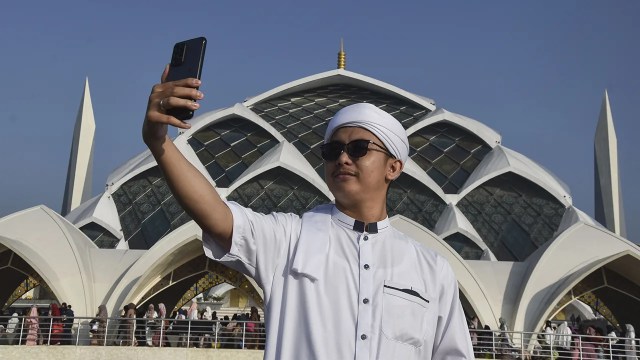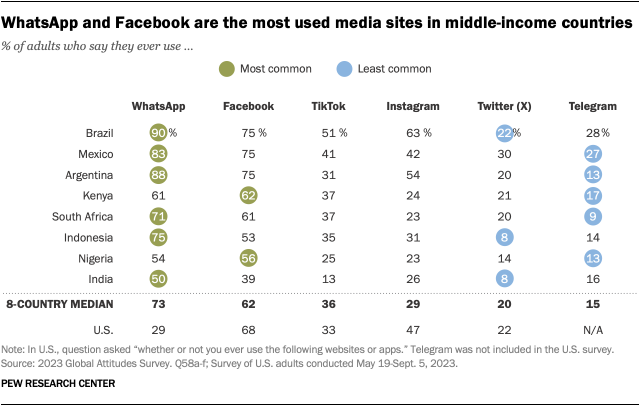
In just a few decades, social media has changed how people around the world interact and communicate. And in eight middle-income countries surveyed by Pew Research Center in 2023, two particular platforms – WhatsApp and Facebook – dominate the social media scene.

Across these eight countries in Latin America, Africa and South Asia, a median of 73% of adults say they use WhatsApp and 62% say they use Facebook. Considerably fewer people say they use TikTok (median of 36%), Instagram (29%), Twitter (20%) or Telegram (15%). The surveys were conducted in Argentina, Brazil, India, Indonesia, Kenya, Mexico, Nigeria and South Africa in 2023, before Twitter was renamed X.
This analysis explores use of various social media sites in eight middle-income countries, as well as in the United States. It relies on data from multiple Pew Research Center surveys:
- International data comes from our 2023 Global Attitudes Survey, which includes surveys in eight emerging and developing economies (Argentina, Brazil, India, Indonesia, Kenya, Mexico, Nigeria and South Africa). These surveys were conducted face-to-face from Feb. 25 to May 22, 2023, with 10,235 adults. Country classifications by income level reflect 2022 World Bank income groupings. Due to questionnaire space and survey mode, we asked these questions only in these eight middle-income countries.
- Our 2023 National Public Opinion Reference Survey (NPORS) was fielded from May 19 to Sept. 5, 2023, through a combination of web and mail surveys of 5,733 U.S. adults.
For more on technology use in the United States, including use of specific social media sites, read “Americans’ Social Media Use” and “Q&A: How – and why – we’re changing the way we study tech adoption.”
Here are the questions used for this analysis, along with responses, and the survey methodology.
WhatsApp, in particular, stands out for its broad reach in middle-income countries. In all eight surveyed countries, at least half of adults use WhatsApp, with shares ranging from a low of 50% in India to a high of 90% in Brazil. In the United States, by comparison, only 29% of adults use WhatsApp.
But Facebook is more popular in the U.S. than it is in some of these middle-income nations. Around two-thirds of U.S. adults (68%) use Facebook, compared with smaller shares in Kenya (62%), South Africa (61%), Nigeria (56%), Indonesia (53%) and India (39%).
Use of TikTok and Twitter is generally similar in the U.S. and in the middle-income countries we surveyed. For example, a third of U.S. adults use TikTok, similar to the median of 36% across the eight middle-income countries. Even in India – where TikTok is officially banned – 13% of adults say they use the platform.
We did not ask about Telegram use in the U.S. and, conversely, we did not ask about YouTube – the most popular social media site in the U.S. – in the middle-income countries surveyed.
Social media use is more common among young people, higher-income people in emerging economies
Younger people are far more likely than older people to use social media, including specific social media sites. For example, in India, three-quarters of 18- to 29-year-olds use WhatsApp, compared with only 17% of those ages 50 and older. This pattern is consistent across nearly all social media platforms we asked about, although the differences are not always as large.
People with more income are more likely to use most of the specific social media sites we asked about in each of the countries surveyed. For example, 63% of Nigerians with incomes above the national median use Facebook, compared with 41% of Nigerians who earn less than the national median.
There are similar differences by education too, with higher use of these social media sites among people with more education.
Note: Here are the questions used for this analysis, along with responses, and the survey methodology.



